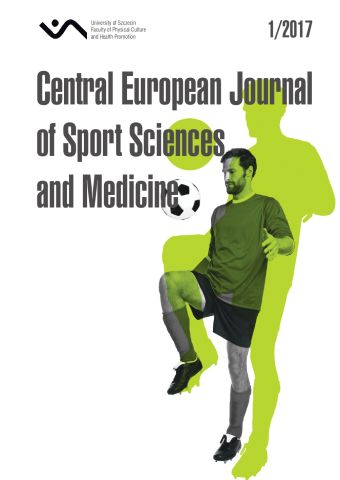
ISSN: 2300-9705
eISSN: 2353-2807
OAI
DOI: 10.18276/cej.2017.1-02




Issue archive /
Vol. 17, No. 1/2017
The Use of Artificial Neural Networks in Supporting the Annual Training in 400 meter Hurdles
| Authors: |
Janusz
Iskra
Faculty of Physical Education and Physiotherapy, Opole University of Technology Krzysztof Przednowek Faculty of Physical Education, University of Rzeszow Krzysztof Wiktorowicz Faculty of Electrical and Computer Engineering, Rzeszow University of Technology Tomasz Krzeszowski Faculty of Electrical and Computer Engineering, Rzeszow University of Technology |
| Keywords: | 400 meter hurdles artificial neural networks planning training loads |
| Data publikacji całości: | 2017 |
| Page range: | 10 (15-24) |
Abstract
This paper presents an evaluation of the annual cycle for 400 m hurdles using artificial neural networks. The analysis included 21 Polish national team hurdlers. In planning the annual cycle, 27 variables were used, where 5 variables describe the competitor and 22 variables represent the training loads. In the presented solution, the task of generating training loads for the assumed result were considered. The neural models were evaluated by cross-validation method. The smallest error was obtained for the radial basis function network with nine neurons in the hidden layer. The performed analysis shows that at each phase of training the structure of training loads is different.
Download file
Article file
Bibliography
| 1. | Alejo, B. (1993). Weight training for the 400 m hurdler. Track Technique, 123, 3915–3918. |
| 2. | Arlot, S., Celisse, A. (2010). A survey of cross-validation procedures for model selection. Statistics Surveys, 4, 40–79. |
| 3. | Balsalobre-Fernández, C., Tejero-González, C.M., del Campo-Vecino, J., Alonso-Curiel, D. (2013). The Effects of a Maximal Power Training Cycle on the Strength, Maximum Power, Vertical Jump Height and Acceleration of High-Level 400-Meter Hurdlers. Journal of Human Kinetics, 36, 119–126. |
| 4. | Bishop, C. (2006). Pattern recognition and machine learning. Springer. |
| 5. | Bompa, T.O., Haff, G. (1999). Periodization: Theory and methodology of training. Human Kinetics Champaign. |
| 6. | Brejzer, W., Wróblewski, J.P., Koźmin, R. (1984). 400 m s/b. Raspriedelienie treninrowocznych nagruzok. Legkaja Atletika, 12, 12–13. |
| 7. | Guex, K. (2012). Kinematic Analysis of the Women’s 400 m Hurdles. New Studies in Athletics, 27 (1/2), 41–51. |
| 8. | Gupta, S., Goswami, A., Mukhopadhyay, S. (1999). Heart rate and blond lactate in 400 m flat and 400 m hurdle running: a comparative study. Indian Journal of Physiology and Pharmacology, 43 (3), 361–366. |
| 9. | Hiserman, J. (2008). A program design method for sprint & hurdle training. Jim Hiserman, C.S.C.S. |
| 10. | Husbands, C. (2013). Sprinting: Training, Techniques and Improving Performance. The Crowood Press, Ramsbury. |
| 11. | Iskra, J, Ryguła, R. (2001). The optimization of training loads in high class hurdlers. Journal of Human Kinetics, 6, 59–72. |
| 12. | Iskra, J. (2001). Morfologiczne i funkcjonalne uwarunkowania rezultatów w biegach przez płotki. Katowice: AWF. |
| 13. | Iskra, J. (2012a). Badania naukowe w biegach przez płotki. Katowice: AWF. |
| 14. | Iskra, J. (2012b). Athlete typology and training strategy in the 400 m hurdles. New Studies in Athletics, 27, 1–2, 27–37. |
| 15. | Iskra, J., Przednowek, K. (2016). Influence of fatigue in the selected kinematic parameters of hurdle clearance in 400 metre race – in search of an accurate training test. The 34th International Conference on Biomechanics in Sports, Tsukuba, 687–690. |
| 16. | Iskra, J., Walaszczyk, A., Mehlich, R. (2006). Principles of 400 m hurdle training. Track Coach, 177, 5641–5645. |
| 17. | Iskra, J., Widera, J. (2001). The training preparation of the world junior 400 m hurdles champion. Track Coach, 156, 4980–4984, 4997. |
| 18. | McFarlane, B. (2000). The Sciences of Hurdling. Canadian Track and Field Association, Ottawa. |
| 19. | Otsuka, M., Ito, M., Ito, A. (2010). Analysis of hurdle running at various inter-hurdle distances in an elementary school PE class. International Journal of Sport and Health Science, 8, 35–42. |
| 20. | Przednowek, K., Iskra, J., Cieszkowski, S., Przednowek, K.H. (2015). Planning training loads to develop technique and rhythm in the 400 m hurdles using RBF network. In: Proceedings of the 3rd International Congress on Sports Sciences Research and Technology Support (icSPORTS 2015), (pp. 245–249). Lisbon, Portugal. |
| 21. | Quinn, M.D. (2010). External effects in the 400-m hurdles race. Journal of Applied Biomechanics, 26 (2), 171–179. |
| 22. | Smith, M. (2005). High performance sprinting. The Crowood Press, Ramsbury. |
| 23. | Sozański, H., Sadowski, J., Czerwiński, J. (2015). Podstawy teorii i technologii treningu sportowego. Tom II. Warszawa–Biała Podlaska: Akademia Wychowania Fizycznego. |
| 24. | StatSoft Inc. (2011). STATISTICA (data analysis software system), version 10. www.statsoft.com. |
| 25. | Ward-Smith, A. (1997). A mathematical analysis of the bioenergetics of hurdling. Journal of Sport Sciences, 15, 517–526. |
| 26. | Wiktorowicz, K., Przednowek, K., Lassota, L., Krzeszowski, T. (2015). Predictive Modeling in Race Walking. Computational Intelligence and Neuroscience, Article ID 735060. |
| 27. | Winckler, G. (2009). Producing extraordinary sprint runners. In: I. Mujika (ed.), Tapering and peaking for optimal performance. (pp. 155–160). Champaign: Human Kinetics. |
| 28. | Zouhal, H., Jabbour, G., Jacob, B., Duvigneau, D., Botcazou, M., Ben Abderrahaman, A., Prioux, J., Moussa, E. (2010). Anaerobic and aerobic energy system contribution to 400-m flat and 400-m hurdles track running. Journal of Strength and Conditioning Research, 24 (9), 2309–2315. |